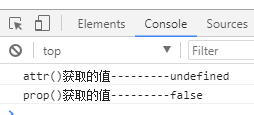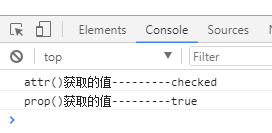写个例子比较下attr()与prop()的差异
<body>
<input type="radio" name="radio1" class="radio-btn">
<label>男</label>
<script type="text/javascript">
$(document).ready(function(){
// attr()获取的checked
var checkedAttr=$(".radio-btn").attr("checked");
console.log("attr()获取的值---------"+checkedAttr);
// prop()获取的checked
var checkedProp=$(".radio-btn").prop("checked");
console.log("prop()获取的值---------"+checkedProp);
});
</script>
</body>效果图:


如果给input添加checked属性


由此可知prop()方法获取属性统一返回true或false,attr()则返回undefined或checked
在做项目中,我遇到了使用attr()方法禁用单选按钮点击事件失效的问题,后来翻看好多资料,显示jquery版本在1.6+以上就用prop()代替了attr(),特别是如checked, selected 或者 disabled这一类的属性(具有true和false两个属性值的属性),最好使用prop()方法,其他的可以使用attr()方法
以下是官方建议attr(),prop()的使用:
| Attribute/Property | .attr() | .prop() |
|---|---|---|
| accesskey | √ | |
| align | √ | |
| async | √ | √ |
| autofocus | √ | √ |
| checked | √ | √ |
| class | √ | |
| contenteditable | √ | |
| draggable | √ | |
| href | √ | |
| id | √ | |
| label | √ | |
| location ( i.e. window.location ) | √ | √ |
| multiple | √ | √ |
| readOnly | √ | √ |
| rel | √ | |
| selected | √ | √ |
| src | √ | |
| tabindex | √ | |
| title | √ | |
| type | √ | |
width ( if needed over .width() ) | √ |




 本文通过示例对比了jQuery中attr()与prop()方法在处理checked等布尔属性时的不同表现。并根据官方建议总结了两种方法在不同场景下的适用性。
本文通过示例对比了jQuery中attr()与prop()方法在处理checked等布尔属性时的不同表现。并根据官方建议总结了两种方法在不同场景下的适用性。

















 954
954

 被折叠的 条评论
为什么被折叠?
被折叠的 条评论
为什么被折叠?








